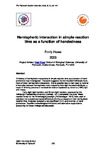Hemispheric interaction in simple reaction time as a function of handedness
| dc.contributor.author | Howe, E. | |
| dc.date.accessioned | 2019-05-13T10:22:46Z | |
| dc.date.available | 2019-05-13T10:22:46Z | |
| dc.date.issued | 2009 | |
| dc.identifier.citation |
Howe, E. (2009) 'Hemispheric interaction in simple reaction time as a function of handedness', The Plymouth Student Scientist, p. 90-107. | en_US |
| dc.identifier.issn | 1754-2383 | |
| dc.identifier.uri | http://hdl.handle.net/10026.1/13856 | |
| dc.description.abstract |
Efficiency of hemispheric interactions in simple reaction time as a function of hand preference was investigated. Research suggests that left-handed individuals have more efficient hemispheric interactions. This is possibly due to their need to transfer information between hemispheres more frequently than right-handed individuals, a result of differing patterns of cerebral dominance explained by Annett’s (1998) right shift theory. Forty-eight right-handers and 48 non-right-handers, assessed by the Edinburgh Handedness Inventory (Oldfield, 1971) completed the study. Mean reaction times for the Poffenberger paradigm (Poffenberger, 1912) were used to calculate the crossed-uncrossed-difference (CUD); a measure of inter-hemispheric transfer time. Analyses revealed a non-significant CUD, and no effect of hand preference. Possible methodological limitations and alternative explanations accounting for these findings are discussed. | en_US |
| dc.language.iso | en | en_US |
| dc.publisher | University of Plymouth | |
| dc.rights | Attribution 3.0 United States | * |
| dc.rights.uri | http://creativecommons.org/licenses/by/3.0/us/ | * |
| dc.subject | hemispheric interactions | en_US |
| dc.subject | right shift theory | en_US |
| dc.subject | cerebral dominance | en_US |
| dc.subject | hand preference | en_US |
| dc.subject | cerebral dominance | en_US |
| dc.subject | handedness | en_US |
| dc.title | Hemispheric interaction in simple reaction time as a function of handedness | en_US |
| dc.type | Article | |
| plymouth.issue | 1 | |
| plymouth.volume | 2 | |
| plymouth.journal | The Plymouth Student Scientist |




